|
Deck: Tarot of the Apocalypse
by Światosław Nowicki,Robert Sobota,Magdalena Walulik. |
Created on Phuture Me |
Also available in our Tarot & Numerology App for Apple iOS & Android
 |
 |
Screenshot

The Gypsy Will Tell You the Truth …
The Queen of Pentacles is a fortune teller, witch, herbalist, gypsy; whatever you call her, she is a relic of paganism hated by all the churches (burning of the witches etc), who functions at the peripheries of the Christian world in competition with institutionalized religion or as its supplement. She has her own insight into the spiritual world and with it she provides services to people.
On the card we see a fortune teller as an old witch sitting behind a table, with her tools ready for action. These are the crystal ball, a pendulum, the tarot, a burning candle. Next to the witch there stands a cauldron with a magical herbal brew. Behind her in the window there is a spider web with a fly in it, with the starry night sky and the crescent moon outside. The witch has an owl on her shoulder and the tarot in her hands. One of the cards – the Devil – is being shown to us. She wears a pentacle the pentacle – her attribute - as a broach. We can also see the hand of her client, who came to find out what he does not know and pays for the service with a few denarii dropped on the table. At the front of the card a large cat is staring at us baldly.
The power of the witch is different from the spirituality which is the principle of the Christian religion. It draws from animalistic energies instead of denying them, as is required and symbolized by the sword piercing the bull’s neck (see the Hierophant and Justice). This is indicated by the presence of the large cat and a few other animals, other than the standard four beasts of the Apocalypse: the bull, the lion, the eagle and the angel. The Queen of Pentacles prefers the company of her cat and the owl, the spider and his fly and …The devil.
As the Bride who personifies paganism, the witch is rather the devil’s bride. She is old yet can lure one with inexplicably strong sexuality. As if in an alchemical process, sexual energies are transformed here into magical powers. This is what the cauldron with the mysterious herbal potion stands for, whereas the cat embodies magical animalism, not the ordinary animal strength of the bull. The cat’s eyes, just like the eyes of an owl, can see in the darkness, into the night sky.
The witch’s knowledge is of the “moon” type, far from the bright daytime solar consciousness. It is drawn from the darkness of the unconscious mind with the subtle senses symbolized by the spider web. What the fly in the spider web tells us is that the fortune teller, in competition with the religion that catches souls like fish in the net (see the Moon) also tries to catch and control its clients. The fact that the witch is shown here on the last court card suggests that when the entire potential of the Christian religion is used up, this pre-Christian source of energy will always be there.
The Queens in this tarot deck represent different denominations which separated within Christianity.

Be the Shepherd to My Sheep
This card portrays Saint Peter sitting on a throne. The resurrected Christ is putting a papal tiara on his head and with this gesture he passes on the authority over his church to Peter. This goes back to the event at the Sea of Tyberias, after the plentiful fishing which was one of Christ’s miracles.
Peter and the other disciples chosen by Jesus were to be fishermen of human souls – the fish caught by them symbolize all those who believed and became Christian (see the Knight of Pentacles). The miracle at the Sea of Tyberias meant that the fish – the converted souls – would be guided into the net by Christ himself. The card also shows the fish taking a denarius, symbolizing the Word of God, from Christ’s hand. The fish comes out of the cup held by Peter, the King of Cups himself.
The cup – symbolic of feeling and faith - is also an expression of Saint Peter’s character. Peter was the first to believe that Jesus was the Son of God, and he loved Jesus best. Before Christ passed on to Peter the authority over his church, three times he made sure that Peter loved him best, more than any of the other apostles. Three times he also said to him: “Be a shepherd to my sheep”. This is why, in his other hand, Saint Peter is holding a shepherd’s rod, a crosier, and behind him there is a flock of sheep signifying the church of Saint Peter. The people who believed are like a caught fish which now has to be grazed like a sheep, to be controlled and formed in Christian fashion into a sacrificial lamb; the lamb which makes a sacrifice of everything that is human in him and gives himself entirely to God.
Peter’s love for Jesus was expressed in his request for Jesus not to give himself in for death, but Jesus scolded him: “Get away Satan; you are an offence to me; for you are thinking not of the things that be of God, but those that be of men.” Peter also turned cowardly and of small spirit when he denied Jesus three times and then cried bitterly. And this sensitive, overly human disciple Jesus called the rock upon which he would build his church. So it was built more on the waters of people’s feelings and weakness rather than on the hard rock of spiritual perfection.
No wonder that the Roman Papacy, which considers itself to be the continuation of the office given to Peter, has frequently made much more human than divine choices. It turned out to be, as it is called in the Book of Zechariah, a useless shepherd, faithless to his mission, the one who in fact “denied it”. This denial is announced by the crowing of the cock sitting on Peter’s crosier.
The corruption of the papacy later on led to the Reformation. Martin Luther snatched Peter’s sheep from his flock like an eagle and founded his own church, which took over the spiritual mission, abandoned by the papacy, of forming men into Christians.
The Kings in this tarot deck represent the most important male figures in the life of Jesus Christ and the history of Christianity.

God and His Beloved
Religion commands man to turn his spirit to God (see the Pope) and rise above worldly affairs. All hopes that man’s efforts will be rewarded are based on the fact that, after all, the Infinite Absolute himself descended into the finite world, became man, and began the process of breaking through the barriers of finitude, to finally become God as man divinized.
This is the sense of the fundamental Christian dogma of the union of the divine and human nature in Jesus Christ. In the esoteric, philosophical sense the dogma becomes generally true, not the only in the singular case of Jesus.
God the Creator (see the Magician) created heaven and earth, and then he created nature (see the Empress) and himself as man in nature (see the Lovers). As man, he became God in exile, especially when he expelled man from Paradise (see the Chariot).
But at the end of time, when the old earth and the old heaven come to their end and the harlot Great Babylon will be replaced by the New Jerusalem, God will return home from exile, and man will dwell in the house of God, which will become his home. This shared house of God and man, the heavenly city of Jerusalem, will have its gates facing the four parts of the world, and through them all those who come from all corners of the world will be welcome.
In the New Jerusalem, Christ celebrates wedding his Beloved, with the divinized part of mankind, God’s people. The Lover is one, and the Beloved comprises a limitless crowd of spirits. Everyone who Christ, the High Judge, lets into the New Jerusalem (see Judgment) is the Truth and Eternal Life. How different are these spirits from Christ? They are not different at all. From his point of view, he is the Husband and everyone else is his Wife.
But at the same time, every spirit is a unique individuality and, as such, must reach eternal life. The whole abundance of the Absolute, embodied in the creation, is to return to God as the multiplicity of spiritual beings; each of them expressing some specific, unique aspect of the whole to the extent that, without it, the whole would be incomplete.
The New Jerusalem is a fractal – each of its elements is of a similar structure to the whole. The self of the enlightened as the Lover spreads over all the individualities that he used to be in previous incarnations, being his Beloved (see Death).
The New Jerusalem is a final product of man’s history. The driving forces of man’s history, symbolized by the bull, lion, eagle and angel, have nothing else to accomplish. God has his tent here, in which he meets his Beloved, descending from his heights, as she flies to him giving him a helping hand as his Beloved (see the Hangman), and leaving the superfluous earth behind. The Beloved is the female snake-holder, just as the Lover is the male snake-holder (see the Lovers).

The 5 of Swords is a card of an empty and pointless victory, embarrassing or humiliating situations, quarrels and even violence. 5s are never welcome cards in any tarot reading and Swords are often troublesome. This card especially is a warning not to be taken lightly. In the Rider Waite Smith (RWS) deck the imagery is one of the aftermath of a battle. The victor picking at the remains. The defeated have turned their backs and walked away. This is a man without friends. There's no real prize here for anyone and the bleak landscape and grey sky sums up the mood of despair for all. What was the purpose of the fight? To strengthen an ego hell bent on it's desperate need to be right? The pitfall of being viewed as sanctimonious? This tragedy could have been avoided through diplomacy, listening to what others have to say, accepting differing opinions and searching for, and reaching, common ground.
The RWS 5 of Swords scene is the aftermath of a quarrel with one person looking very self satisfied and the other two, backs turned, leaving the scene. There are no friends here, no unity, only loneliness and despair. Too often we allow our views of the world, our identities, our religious or political beliefs to drive a wedge between us. By placing less value and priority on these abstract mental constructs we can build bridges between us and create harmony for all.
All the cards in the Minor Arcana numbered 5 are problematic cards. The number 5, in numerology, has the negative qualities of being chaotic, unstable, self-indulgent, irresponsible or careless and Tarot's Minor 5s reflect those negatives. If we look to the 5s in the Major Arcana we find positive cards which offer a solution to this chaos. Card number 5 of the Major Arcana is The Hierophant which represents conformity, doctrine, laws and rules that bring order from chaos. It represents not just the church and religious law but all establishments of authority which people live and work under. The other 5 in the Major Arcana is card number 14 Temperance (numerology reduces 14 to 5) which represents self control. When dealing with the 5 of Swords in a Tarot spread these additional cards maybe the warning, or the solution, of what sort of control will be applied to the unruly behaviour of this card. External control or self control.
The central character in the RWS 5 of Swords holds 3 swords symbolising the numerological link to the 3 Of Swords, the card of despair and heart ache. The 2 remaining swords on the ground are a numerological link to the 2 Of Swords symbolising the ignored diplomatic option which could have prevented this situation from occurring. They also serve as a link to Judgement and Justice in the Major Arcana. Both cards have numerological values of 2 and this symbolic connection may carry a warning of the consequences of his actions.
The Suit of Swords, representing the Element of Air, symbolises the mental and intellectual aspects of life. The storms on the path of life that we have to apply our minds and intelligence to navigate through. Like the steel in the sword we are tempered by the hammer and flames of life's challenges and trials. The negative characteristics and meaning of the number 5, in numerology, are instability, chaos, self-indulgence, irresponsibility, procrastination, thoughtlessness and carelessness. This combination of element and numerology would suggest not focusing on doing one thing well but many things badly. Not thinking things through properly and being forceful in gaining the upper hand, or short term victory, only for it to later turn against you into isolation, defeat and humiliation.
© Phuture Me Ltd 2010-2019. All rights reserved.
THE PICTORIAL KEY TO THE TAROT
By Arthur Edward Waite (1911)
A disdainful man looks after two retreating and dejected figures. Their swords lie upon the ground. He carries two others on his left shoulder, and a third sword is in his right hand, point to earth. He is the master in possession of the field. Divinatory Meanings: Degradation, destruction, revocation, infamy, dishonour, loss, with the variants and analogues of these. Reversed: The same; burial and obsequies.
Related Tarot Cards
 |
 |
 |
 |
 |
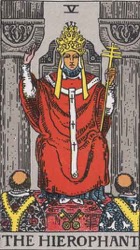 |
 |
 |
 |
© Phuture Me Ltd 2018. All rights reserved.

A sealed book
Fate, destiny, doom – what is it? For ancient Greeks it was a power that even the gods could not interfere with. In the Apocalypse, God on the throne holds The Book of Destiny, and all he can do is to get to know its contents and make sure that what is to happen will happen. We people also have our fate written down; we plan it ourselves before we are born, but when we live on earth we are unaware of it, we have forgotten about it. Whatever should happen will happen, but the way we will behave in the face of our fate and what we are going to learn depends on us. If we knew it beforehand, life on earth would be unnecessary. The Wheel of Fortune turns and we ourselves turn the wheel and stand in confrontation with the changing paths of fate. The greatest wisdom is to welcome one’s fate.
God expelled man from Paradise (see the Chariot) so that man coped in exile as best as he could, but then he also gave him the Ten Commandments (see Justice) to set boundaries to man’s freedom. It was difficult to know what would come out of it. Will man follow God’s commandments? What will God do if man disobeys him? What will God gain if man is in fact obedient?
God started a game with man, which really means a game with a separated part of himself. He can change the rules at random, depending on how the game develops; depending on whether his own moves are going to bring the desired effects, and if so, on whether he will be satisfied, or will conclude that this was not exactly what he wanted. And it is only during the game that God will slowly realize his real intention towards the creation of man
But on the other hand, all that is to happen has been set out, and what is to happen will happen. This is what is written in the book sealed with seven seals. Until, finally, someone who had gained enlightenment and could unravel the mystery of the world’s fate tore the seals from the book. It was the seven-horned Lamb, the Son of God, Jesus Christ. Once he tore the first seal away, he saw himself on a white horse, embarking on a journey into the world, to join the realization of God’s plan which was now known. At the same time, he saw the beginning of the new era in history – the Christian era (see the Sun).
The powers acting throughout man’s history are represented by four figures, well-known to us by now: bull, lion, eagle and angel. They turn events round just like the Wheel of Fortune, divided into seven sectors that correspond to the seals of the book. Each one of the figures sends out one of the “four riders of Apocalypse” to fight.
God has not created the world and man in it for man to turn away from the world, and fly to heaven (see the Hermit). God’s aim is realized through earth’s history, so it cannot happen at random. This is why the seven-horned Lamb finally enters the scene.
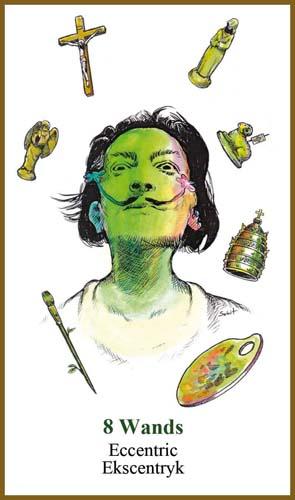
In the 8 of Wands tarot card we have a mix of some very powerful symbology. The Suit of Wands, and its element of Fire, symbolises energy, passion and drive. It is the fire that burns in the home and within the engines of our transport and industry. In numerology the number 8 gives you a "can do, will do" energy and ambition. It puts you in control with the focus to get things done. Not only the ambition but also the direction and resources to manifest goals. Combining the number 8 with the element of fire it would be perfectly correct for a 21st century tarot card to have a picture of a space rocket for the 8 of Wands. Or less dramatic, a cup of very strong coffee!
The Rider Waite Smith (RWS) deck was published at the turn of the 20th century only 6 years after the Wright Brothers achieved the first flight. Had Pamela C. Smith illustrated her deck 100 years later it may well have been a space rocket she would have used. Instead she illustrated what is probably the simplest card in her deck showing 8 wands flying together through the air over a simple, green, countryside. Smith uses the same background from her Ace of Wands but seen from a different perspective. In the Ace things have just started with a single wand being held upright by a hand. In the 8 of Wands things have progressed, multiplied, and are really moving on their own with no hands and no people. The 8 of Wands is the only card in the RWS deck not to feature a character or an additional prop. The The Wheel of Fortune has its Greek, Egyptian and biblical creatures and the 3 Of Swords has its sword pierced heart. The 8 of Wands has nothing other than a simple background and 8 flying wands.
When illustrating a Tarot card there is a danger of influencing the deck user too much by depicting an overly elaborate story which distracts users from the basic symbology. A good Tarot deck should have cards that remain open and fluid to interpretation. To become proficient in Tarot you must always be aware of what is missing as well as what is being presented to you. Smith's decision to exclude any characters, or props, from only this card may have been to emphasise the point that this card relates to forces that have already been set in motion and are out of anyones control. Like arrows that are already in flight one can only wait and see where it is they land, if they hit their target and what damage they do if any.
The 8 of Wands, 8 of Rods or 8 of Batons, is a card symbolising swift action, travel and expansion. The element here is Fire which relates to home, community, work and projects. The aspects of the number 8 in numerology are power, control, ambition, organisation, practicality, focus and success. This card is more commonly depicted as 8 wands flying through the air. This may have the metaphorical meaning of things changing swiftly and for the better. Its meaning can also be literal and the appearance of this card could indicate travel by air in the future.
© Phuture Me Ltd 2010-2019. All rights reserved.
THE PICTORIAL KEY TO THE TAROT
By Arthur Edward Waite (1911)
The card represents motion through the immovable-a flight of wands through an open country; but they draw to the term of their course. That which they signify is at hand; it may be even on the threshold. Divinatory Meanings: Activity in undertakings, the path of such activity, swiftness, as that of an express messenger; great haste, great hope, speed towards an end which promises assured felicity; generally, that which is on the move; also the arrows of love. Reversed: Arrows of jealousy, internal dispute, stingings of conscience, quarrels; and domestic disputes for persons who are married.
Related Tarot Cards
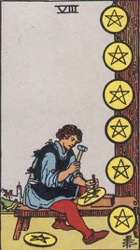 |
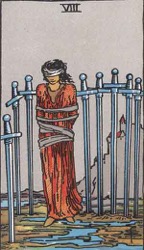 |
 |
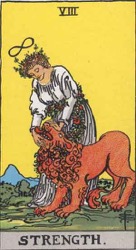 |
 |
© Phuture Me Ltd 2019. All rights reserved.

The Rider-Waite-Smith (RWS) deck depicts the 4 of Pentacles as a minor, modestly dressed, king hoarding 4 pentacles, or coins. He sits on a stone box with a town or city visible in the background. The 4 of Pentacles is the bankers card where wealth is stored and safely guarded. The wealth that is stored there belongs to the King Of Pentacles. This RWS card is an unusual card for two reasons.
The first reason is because the Tarot deck contains only 4 Kings and 1 Emperor but the artist chose to add an additional king in this card. There is also a king in the Death card, lying dead on the ground, because the Kings and The Emperor are linked to Death through their numerological symbolism of the number 4 (Death is 13 which reduces to 4. 1 + 3 = 4). This connection between death and wealth may refer, on rare occasions, to an inheritance.
The second reason is because this character is looking directly at you with his attention in the present moment. This is a rare feature for a minor arcana card as it can only be found in the King Of Swords and the 9 Of Cups where as in the Major Arcana approximately half of the cards in that suit have this symbolism of present moment attention and contentment. Therefore the symbolism portrayed by the king's attention in the 4 of Pentacles is one of being happy with what you have materially even though it is just a modest amount.
The negative aspects of the 4 of Pentacles are depicted in this minor king having each foot on a pentacle embossed coin while tightly clutching one to his chest with both arms. This contentment with your material wealth makes you unwilling to invest, spend or share any of it. This is a stagnant situation which doesn't allow for growth or change. A common trait of the number 4 and part of the symbology of the Kings, the Emperor and Tarot's Death card. If something stagnates, and stops growing and evolving, it risks death and extinction. Life is cyclic and constantly changing, death breaks cycles. As you browse through the cards in the Suit of Pentacles notice how the wealthy and materially prosperous cards are set in rich gardens or lands. The cards without wealth have little or no plant life to be seen and it is in this category the 4 of Pentacles falls.
The 4 of Pentacles, or the 4 of Coins, is a card of financial security, stubbornness, greed and inflexibility. The element here is Earth which relates to wealth and material possessions. The aspects of the number 4 in numerology are security, patience, endurance, restriction, hard work, and rigidity. The 4 is thought of in many cultures as an unlucky number and this card's appearance would not be a good long term omen for personal wealth. Nothing is coming into the bank and although it may seem prudent not to spend in these circumstances it is preventing investment for the future.
© Phuture Me Ltd 2010-2018. All rights reserved.
THE PICTORIAL KEY TO THE TAROT
By Arthur Edward Waite (1911)
A crowned figure, having a pentacle over his crown, clasps another with hands and arms; two pentacles are under his feet. He holds to that which he has. Divinatory Meanings: The surety of possessions, cleaving to that which one has, gift, legacy, inheritance. Reversed: Suspense, delay, opposition.
Related Tarot Cards
 |
 |
 |
 |
 |
© Phuture Me Ltd 2018. All rights reserved.

Aces are like plant seeds. These small, self contained, capsules can bring forth something new and, with a bit of luck, the right environment, nurturing and maintenance, can continue to grow and last for many seasons and years. Some don't grow at all and fail early. Some don't turn out as hoped and should be discarded to free space for growing something better. The Ace of Cups can be thought of as an emotional seed. Just as every seed is different so too is every appearance of the Ace of Cups. This card could signify a new friendship which maybe be short lived or may last a life time. It could be a new love interest but not one that progresses as far as a date and is unrequited. Or it may turn into a relationship or platonic friendship. With Aces, just like seeds, you really don't know how it is going to turn out until you try to grow it. All you know is that you have the potential to grow something new.
Numerology isn't well known or understood but there is no need to explain what the number 1 symbolises to most people. It is the number of a winner, a leader. It is premium and premier. These are the desired traits we all easily associate with 1 but we must remember that 1 is also symbolic of a beginning, a first step in a sequence, cycle or journey. It can also symbolise independence and individualism and with the Ace of Cups this would be emotional independence.
The Rider Waite Smith (RWS) deck added a lake covered with lily pads as a background to the Ace of Cups and included a hand, holding the cup, coming out of a cloud hovering over the ground. The Lily is symbolic of chastity and purity. The inclusion of the cloud, as the source of the hand, is there to symbolise the divine origin of all things. It serves to remind us of the greatest mystery of all - where does everything come from, and return to, including ourselves?
The Ace of Cups is traditionally represented as a single vessel filled with water. Its symbology is simple, it has the element of water and a numerological value of 1. As a 1 it represents a new beginning and, with water as the element, this beginning is an emotional one. The card more commonly heralds the coming of a new acquaintance or friend. Since 1's are, in numerology, singular it is less likely to signify a romantic relationship but not impossible. This card is about an individual emotional connection which may not be reciprocated. There are other cards which are more strongly associated with romantic relationship such as the 2 Of Cups, the 10 Of Cups or The Lovers. The Ace of Cups allows the freedom of deciding if and how to grow this emotional connection which may influence the direction it takes at a later stage. The Ace of Cups may also have a link to the Christian symbology of the Holy Grail and its promise of spiritual re-birth and renewal.
© Phuture Me Ltd 2010-2019. All rights reserved.
THE PICTORIAL KEY TO THE TAROT
By Arthur Edward Waite (1911)
The waters are beneath, and thereon are water-lilies; the hand issues from the cloud, holding in its palm the cup, from which four streams are pouring; a dove, bearing in its bill a cross-marked Host, descends to place the Wafer in the Cup; the dew of water is falling on all sides. It is an intimation of that which may lie behind the Lesser Arcana. Divinatory Meanings: House of the true heart, joy, content, abode, nourishment, abundance, fertility; Holy Table, felicity hereof. Reversed: House of the false heart, mutation, instability, revolution.
Related Tarot Cards
 |
 |
 |
 |
 |
 |
© Phuture Me Ltd 2019. All rights reserved.

We can’t remember who we are
The Spirit exists in this world locked in a human body, having altogether little awareness: it has no idea why it’s embodied, where it comes from or where it really is. It is the Fool.
When God creates man in his own image (see The Lovers), the situation becomes slightly clearer, but only for God: it is as if he creates himself within his creation. The Fool, however, is unaware that he is a fraction of the God who created this world; he does not know that his task is to unravel himself in the world, and the world in himself. He does not walk through the world alongside God the Creator, also his Creator, who is the source of all of his knowledge. Perhaps he used to know in Paradise, but then man left Paradise long ago.
As things are, all he has left is religion. Still, if the human heart is the source of all religion then what kind of religion is it, if man does not feel at home in the world? Perhaps the kind that tells us that good God is somewhere far away and the world, as we experience it, is the creation of the evil God, who imprisoned the good God in his cosmos, made him a slave to planets and now plays a cruel game?
If so, it would be most reasonable to abandon this world, leave the prison of the body. But the body has the spirit under its control, and commands it to hold on to life, as if there was no other life, or death was something both painful and horrid, so it is better after all to continue living, and bear life as it is. The body holds onto the spirit like a troublesome dog holds on to one’s trousers, and it forces it to stay on earth.
Yet somewhere deep inside the spirit, there lives the memory of a different life. When on a dark and starry night the Fool gazes into the sky, the feeling arises in him that he is looking at where his home is; that the Sun, around which our world revolves, and which darkens the light of his own star, is some kind of intimidating and hostile force that lured him to earth and keeps him trapped here.
Everyone who lives on earth came here from another world, from the spiritual world. We all live in our bodies, not for the first time and probably not for the last. While we live here, we know nothing about where we come from and how many times we have already lived in the material world. We know nothing clearly or distinctly, but somewhere there, at the depths of our memory, there lie all our memories of this other world and our former lives, as if they were thrown into a sack into which cannot peep, yet has to be carried around.
If the Fool gets used to the earthly life, gets to enjoy the delights it has on offer, and feels at home here, he is under the rule of Mammon. If he is never rid of the longing for home, if he feels on earth as if in exile and, instead of living a serious life, thinks only about the end of it, it is Lucifer who is his master. But if man is aware of why he is here, if he understands that life on earth is truly meaningful, even if for reasons other than the short life itself, he shall enter the right path, the path of Christ.

Enlightenment
Enlightenment is being born again. In this card, a woman is standing on the moon, representing a symbol of the accumulated experiences of the previous incarnations; all that happened prior to this life, which is finalized in the Enlightenment (see Death). The Enlightenment is expressed by the Sun around the child’s head - the child being the enlightened one - and by the child opening the lion’s mouth, which stands for the expansion of the ordinary, finite human self into the infinite enlightened self. The twelve stars above the woman’s head are her new offspring, the New Jerusalem, the collective Beloved of God (see the World). Each of these stars is, in itself and for itself, the same as the sun. Each one is the Lover.
Man is born, comes into the world, dies and is born again... until finally he is born into another life, but this time as the Son of God. The Apocalypse defines someone like this as a winner. The winners are called saints, the saved. In the Orthodox Church, on the other hand, the process itself is called the divinization of man. Moreover, the synonym of the enlightened in Christianity is the Son of God, although this term is usually used only in reference to Jesus Christ. In The Apocalypse, however, there are many winners. The truth is that all people will sooner or later win, by being born again out of Spirit.
In the Gospel of St. John, Jesus is talking to Nicodemus, a Pharisee, about the need to be born again, but Nicodemus does not know what Jesus means. He thinks that he will need to go back to his mother’s womb and be reborn from her body again. Jesus, in his life, was born again as Christ, and only then could he be called the Son by God the Father.
In Eastern spiritual doctrines the winners, all those who are born again, are called the enlightened. The enlightenment process is linked in these doctrines with the rising of Kundalini, the fire snake.
This is how the birth of the enlightened is described in the Apocalypse. The fiery seven-headed dragon is a fire snake which, by rising, activates in women the seven chakras – the centers of a new, higher consciousness. When these are unsealed and unburdened they become the seven eyes of the Lamb, the seven spirits of God, awakened here, on earth.
The winner is needed by God, because God also experiences enlightenment and is also saved through the winner. God needs the winner, as someone with higher consciousness, to help lead the others to their final destiny (see The Wheel of Fortune). Therefore the newly born Christ is taken to heaven, as the enlightenment is not only his individual business, as is the case in Eastern spiritual systems (see the Hermit) patronized by the fiery dragon Lucifer. The war in the heavens between the individualist Lucifer and the hosts of God who, lead by the Archangel Michael, fought for the higher good and the realization of God’s plan, was precisely about who owns the enlightened.
Free AI Tarot Reading. Sample the Future!
Artificial Intelligence reads Tarot Cards so well you have to see it to believe it!
We'd love for you to try it for FREE and see for yourself why this excites us.





